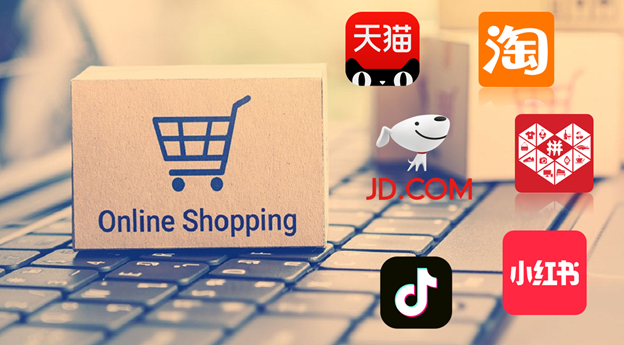The incredible popularity of instant messaging and online shopping in China, along with the adoption of smartphones, has greatly helped China in becoming the largest social network and e-commerce market. As of 2021, it is estimated that the total social network users and digital buyers in China reached 987.3 million and 824.5 million respectively. Behind this trend, there is a growing interest from foreign businesspeople in taking advantage of opportunities arising from China’s digital market.
In this article, we are going to provide you with an overview of the leading social network and e-commerce sites in China, and brief you on their advertising services and related costs, their user demographics, and step-by-step tutorials on platform entry, etc. This will enable you to promote your products and services online more effectively.
1. The social network behemoth for online advertising in China
With almost a billion social network users in China, social media marketing is one of the most effective strategies for international brands to engage with their customers.

Why WeChat?
WeChat was initially released in 2011 under the name of “Weixin”, developed by Tencent Group, it was later rebranded and marketed as WeChat in 2012 to attract international audiences. By the first quarter of 2022, WeChat had 1.29 billion monthly active users in total. It is one of the largest global social networks, placing fifth in terms of total active accounts.
Popular app features on WeChat include voice messaging, moments, scans, games, and mini-programs. It is statistically reported that 61% of WeChat users access moments every time they use the app, hence making WeChat a great platform for foreign companies to launch moments ads for both branding and sales conversion purposes.
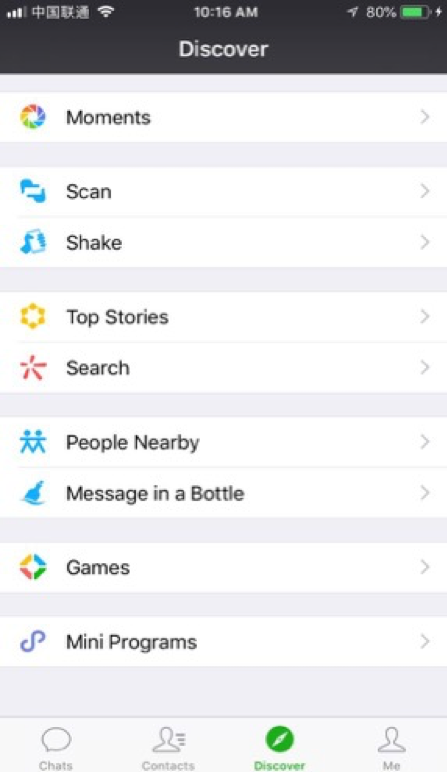
What is WeChat advertising and how does it work?
Digital advertisements on WeChat are typically displayed either through promotional messages on individual user’s moments timeline or at the bottom of the official account’s published articles. WeChat advertising can be categorized into four major groups: moments advertising (which is pretty much the equivalent of ads we see day-to-day on Facebook timeline feed), banner advertising (they are usually featured at the bottom of a message written by a WeChat official account), KOL advertising (involving famous influencers/bloggers to boost conversions), and mini-program advertising (released on Sept. 5, 2017, the newest WeChat promotion channel).
Moments Ads
In general, moments advertising in WeChat can be seen in two formats: picture display ads and video ads. A typical moments ad contains the following content:
- The advertiser’s brand name along with a profile picture
- No more than 6 pics or 6-15 seconds short video
- The description of the ad, up to 40 characters
- A link to a html5 page for further action
Foreign advertisers can target audiences based on their location, age, gender, interest, etc. A single user can see up to one moments ad every 48 hours, and the ad disappears within 6 hours if the user didn’t act on that (like, comment, or click on the link). If actions are put upon the ad from the user, WeChat will increase the likelihood of the user’s friends receiving the same ad on their moments timeline, thus creating a viral effect for the advertiser.
Banner Ads
Banner advertisements on WeChat official account usually come in two formats: standard banner ads & KOL banner version ads. The first one was launched in 2014, and the latter one in October 2016. The KOL mutual ads are much pricier compared with the standard version, and payment is usually based on results.
KOL Ads
KOL ads, also known as Key Opinion Leader ads, are an integral part of WeChat advertising. It was launched in 2016 and quickly recognized as an efficient way to target the audience through collaborating with Chinese influencers. It is important to keep in mind that Weibo KOLs are generally more efficient in pushing e-commerce conversion than WeChat KOLs since they are able to link directly to e-commerce sites like Tmall/Taobao. Instead, within WeChat, users have to go through multiple processes before completing a purchase.
Mini-Program Ads
WeChat launched mini-programs in January 2017, and it quickly went viral by the end of the year. Mini-programs are sub-applications within Wechat. Typically, a mini-program takes up less than 10 megabytes within WeChat, making it fast to run. In 2021, Tencent indicated that over one million mini-programs have been created on WeChat with 450 million active users every day. 67% of WeChat e-commerce Mini-program users are female mini-program.
This extensive user base has greatly sparked many foreign brands’ interests. WeChat supports a variety of mini-program categories, including games, tools, and stores. Advertisements can only be displayed in picture & text format with an external Html5 link. Many advertisers choose to integrate mini-programs into moments ad to increase brand awareness.

Can foreign companies advertise on WeChat? And what are the regulations?
For moments advertising and KOL advertising, both companies registered in mainland China (including wholly foreign-owned enterprises a.k.a. WFOE) and overseas companies can bid for them. Banner ads are mostly restricted to Chinese companies, for foreign advertisers who are seeking to leverage banners ads as their marketing channel, you will be required to prove that:
- You have a registered company in mainland China
- You have all the licenses to justify that you can advertise in the specific industry your ads are associated with. For example, if you want to advertise activewear, you will need to provide all the license paperwork granting you the rights to sell that kind of goods in China.
Foreign Companies’ Access to WeChat Ads

WeChat has issued a series of regulations in terms of advertising audits. Typical industries involved include: B2C e-commerce, gaming, automotive, food, agriculture & aquaculture, we-media, alcohol, educational training, finance, real estate, and cosmetics. For more useful information, please check on WeChat official website.

Companies can pick the specific industry, advertising channel, and promotion objective to get detailed information about advertising restrictions.


How much does it cost to advertise on WeChat?
Moments Ads
As of 2020, the WeChat moments ads use the CPM pricing model through two schemes: scheduled pricing scheme and bidding scheme. Companies looking for flexible digital marketing tools in China usually opt for a bidding scheme, and the minimum cost per day is 1,000 RMB (160 USD). In contrast, in the scheduling scheme, advertisers can set an advertising time duration of 2-28 days. And the pricing of scheduled scheme mostly depends on the target location, which is categorized into three groups: core cities, large cities, and other cities. For example, the charge for per thousand impressions in a core city like Shanghai is 150 RMB (21.8 USD) for picture display ads.
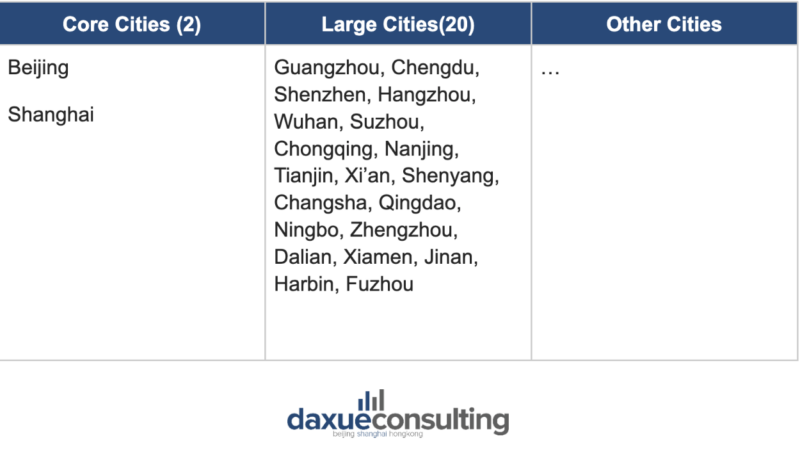
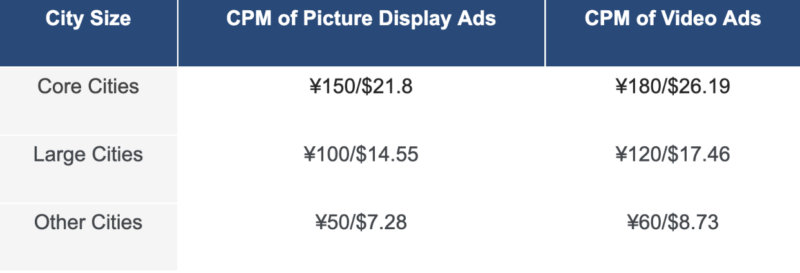
For foreign advertisers targeting Chinese tourists, WeChat moments ad charges 150 RMB (21.8 USD) per CPM for picture display ads and 180 RMB (26.19 USD) per CPM for video ads. Here are some details:

In general, there are three pricing levels for WeChat moments ad, and the features that come with each pricing level can be seen from the table below:

Banner Ads
For the standard version, similar to the moments ads pricing system, both local companies (including WFOEs that are registered in mainland China) and foreign companies need to pay a minimum CPM entry price of 50,000 RMB (7,275 USD).

KOL Ads
The cost of collaborating with Key Opinion Leaders can vary widely. The payment can be either in the format of a flat fee, a performance-based fee, or by giving away your brand products or could be any combination of them. You might find that different WeChat influencers operate on different charging standards, some could be as low as 1,000 RMB (145 USD) for one push message.
Mini-Program Ads
Advertisers can purchase mini-program ads through the bidding system. The minimum CPC is 0.5 RMB (0.073 USD), and the minimum cost per day is 50 RMB (7.28 USD).
Why Weibo?

According to its 2020 first quarter report, Weibo had 582 million monthly active users (MAU). The blogging app is often labeled as the “Chinese Twitter”, but it is actually a far more promising platform in terms of digital marketing opportunities in China for foreign brands than its American counterpart. Considering its impressive user volume and abundant active influencers, Weibo can be an ideal website for foreign brands to launch KOL ads or purely to engage in conversations and interactions with customers.
What does digital advertising on Weibo look like?
There are several channels for foreign companies to advertise on Weibo:
- Paid Hashtag appears on the sidebar next to the timeline feed
- Fans Headline
- is a paid post that appears on top of your followers’ timeline for a limited period of 24 hours
- users can pay to help other accounts’ posts appear on fans’ headline
- Fans Tunnel
- option 1: your chosen post will appear in other users’ timeline with a click button for them to follow
- option 2: you can choose to have your account name with a brief intro displayed on the sidebar next to the timeline
- Search Promotion
- also known as “hot search trends” (热搜), it appears by default in the search bar.
- Banner Ads
- similar to ads on other well-known social platforms like Facebook
- Mobile App Screen Ads
- show up every time when users open their Weibo mobile app
- the display format could be either a plain image or a video with a link redirecting users to a specific webpage
How can foreign companies advertise on Weibo?
Weibo has set up its own advertising website to introduce available marketing platforms and products.

How much does advertising on Weibo cost?
The cost of each advertising approach varies widely. For example, the pricing of fan headline depends on the advertiser’s number of followers. Fans tunnel, on the other hand, typically charges advertisers based on CPE (cost per engagement, which refers to interactions from target audiences, e.g., clicks/reposts/likes) and CPM.

Xiaohongshu, “the Chinese Instagram”

Xiaohongshu, or “Little Red Book”, is often referred to as “the Chinese Instagram”. It is a social network with e-commerce functionality and is one of the most popular social platforms in China today. As of March 2022, the app claimed to have 200 million active users – mostly young women under 32. Thus, it is one of the key platforms in China’s digital marketing ecosystem.
Xiaohongshu combines elements of user-generated content, product reviews, and e-commerce. When users open the app, they see 3 interfaces: “Explore”, which shows content curated by their browsing history; “Nearby”, which allows them to see posts geographically located close to them; and “Follow”, displaying posts by accounts they follow. On Xiaohongshu, users can share content related to a variety of topics, including fashion, lifestyle, food, travel, cosmetics, fitness, and beauty.
Unlike most Western social platforms where users connect with friends, users go on Xiaohongshu to search and share product and service reviews. There are many KOLs and KOCs (key opinion consumers) on Xiaohongshu. These KOLs from different Xiaohongshu channels typically gain popularity by sharing their lives, reviews and opinions online. They’re viewed as specialists in the field and thus have a strong influence on people’s purchasing decisions. Compared to traditional advertisements, users also prefer user-generated content because they’re regarded as more trustworthy and informed.
Digital Marketing on Xiaohongshu
There are 3 major ways of promoting your business on Xiaohongshu:
1) Opening an official account
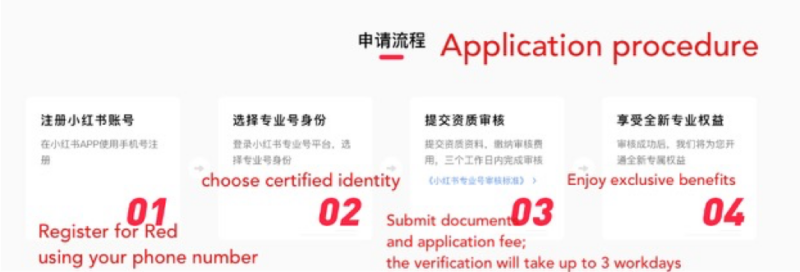
For international brands, it’s possible to set up official brand accounts on Xiaohongshu. To apply, brands must register for an account first and submit the required documents, including:
- Company and owner information
- Company Registration Report, including a Chinese business license and customs registration confirming your sales in China
- Financial information
- Brand information, specialization field, and trademark certificate
After Xiaohongshu reviews and approves all the documents, the brand is enabled to post organic content as well as open an e-shop on the platform. The e-shop will be linked to the Xiaohongshu brand page so consumers can purchase products directly through Xiaohongshu, sparing them the inconvenience of opening another app. Moreover, brands will be granted to track consumer data, buy content promotion, and host livestreams, a rising retailing channel in China.
2) Partnering with KOLs/KOCs
With thousands of influencers on the platform, KOL marketing is the strongest advertising method Xiaohongshu has to offer. Social media influencers often have loyal followers who are more likely to purchase brands they advocate. In addition, KOCs with fewer but niche followers, may boast a stronger influence because they share in-person experiences that are regarded as more trustworthy and unbiased. Brands will need to research, identify, and select the most suitable influencers for themselves.

3) Paid advertisement display
Xiaohongshu also offers the traditional display advertising options: pop-up ads and integrated ads. Pop-up ads are the ones displayed when users open the app. By pressing a button at the bottom of the ad, the users may directly access the brand store.

Integrated ads show on the “explore” page and distinguish from organic posts by small subtitles in the corner that say “guanggao” (广告, which means “advertisement”).
However, because Xiaohongshu is built around authenticity, paid ads are not the main marketing tool brands utilize on this platform since users tend to rely more on user-generated reviews when purchasing. To maintain its positioning as a user community, Xiaohongshu does not run paid ads on an extensive scale. Therefore, it would be better to use paid ads as a supplement to organic content-producing and KOL partnership for digital marketing in China.
Cost of advertising on Xiaohongshu
Display ads
Xiaohongshu uses CPC for display advertising. The minimum bid is 0.3 RMB (0.046 USD); the minimum advertising fee is 5,000 RMB (740 USD).
Display ads on the “Explore” page will be placed on the #6/16/26/36/46 position. For keyword search ads, they will be placed on the #3/13/23/33 position.
KOL partnership
Depending on the KOL size, engagement, and advertisement category, fees can vary a lot.

Bilibili, the key channel for Gen-Z-oriented marketing

Bilibili, or B Site, is a Chinese video sharing platform, sometimes referred to as “the Chinese YouTube”. Established initially as an anime streaming site in 2009, Bilibili is now the largest pop culture and entertainment community for young people. According to its 4th quarter financial report in 2021, its average daily users reached 72.2 million, with 75% aging below 24. Each user would spend an average of 88 minutes on the site.
Bilibili engages actively with the younger generation in China, an emerging consumer group. It hosts a wide variety of sections, ranging from beauty, fashion, food, and lifestyle to technology, sports, entertainment, and documentaries. Thanks to its strict membership rules (to become an official member, one has to pass a 100-question quiz on pop culture), Bilibili establishes a quality user group that keeps the community active and vibrant. Thus, digital marketing on Bilibili is one of the best ways to capture Gen-Z and Millennials in China.
Another special feature of Bilibili is Danmu, or “bullet comments”, which are time-synced comments overlaying the video as it plays. Such feature creates a social experience that allows users to feel connected and strengthens their sense of community.

Digital Marketing on Bilibili
1. Account registration and verification
Companies may register for official accounts with business verifications on Bilibili. Like Xiaohongshu, Bilibili also requires company profile documents upon registration, including:
- Account name, full company name, and company information
- Business license, tax number, and trademark registration
- Business license verification from your country’s embassy in China.
- Any permits related to food safety, cosmetics safety, software admission, mainland China’s ICP license, etc.
2. Paid ads display
Bilibili offers traditional display ad options. There are two options for the Bilibili app:
- News feeds ad, displayed on the home page of the app. These news feed ads are divided into three types:
- Small picture of News Feed: Picture + a title of 5-18 words + a short description of 2-10 words, and promotion of supported web link/application download;
- Large picture of News Feed: Picture + a title of 5-18 words + a short description of 2-10 words, promotion of supported web link/application download; or
- Three pictures of News Feed: Pictures + a title of 5-18 words + a short description of 2-10 words, promotion of supported web link/application download;
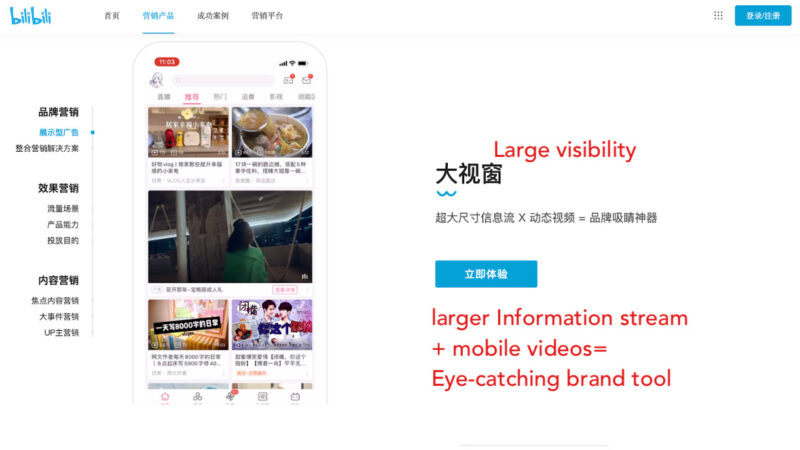
2. First recommendation place at the playing page: Picture + a title of 5-18 words + a short description of 2-10 words, promotion of supported web link / application download / application wakeup
For Bilibili PC version, there are several sizes of banner ads displayed at different locations of the frontpage.

3. Cooperate with KOLs
One of the best marketing strategies on Bilibili is to cooperate with content creators, called UP主. UP主 usually integrate advertisement with high-quality videos and add their personal humor into the creations. This makes Bilibili users more willing to accept advertisements on this platform. Creators can include links to the product underneath their videos, in the Danmu, or in the comment section, allowing smooth purchasing.
4. Integrated marketing on Bilibili
Bilibili also offers integrated marketing solutions.For instance, businesses can launch a hashtag campaign about their products that sparks debates among Bilibili users. KOLs will then promote the campaign by leading one side of the debate, thus attracting their followers to join. This service is usually used for new products promotions. Moreover, brands can utilize Bilibili’s live streaming services to maximize exposure and enhance consumer engagement.

Marketing Cost on Bilibili
Display ads
Bilibili uses the CPC model for display ads on site. The display ranking equals to CPC (cost per click) offer times CTR (clickthrough rate).
After a user clicks on an ad, the cost is deducted from the brand’s account in real-time. Companies will then select their display ad location and determine their advertising target based on demographics, locations, channels, or devices (2 maximum).
Currently, the minimum bid is 0.5RMB/0.073USD. If the offer price is too low or the click-through rate is too low, the ad will not be displayed.
UP主 & KOLs
Companies can also search for UP主 and their prices on Huahuo, an official website by Bilibili that shows the information about each creator (number of followers, average views, engagement, and influence level) with their ad pricing.
For instance, UP主 with 10k followers can price ranging from 1,000-10,000 RMB (148.12-1,481 USD). For UP主 with more followers and better data, the price can be up to tens of thousands of RMB.
2. The e-commerce gorillas in China
Taobao, Tmall, and JD
Taobao is often referred to as China’s eBay with over 10 million stores, specializing in C2C online retail, whereas its sibling – Tmall (a.k.a. Taobao Mall) has been focusing on improving B2C shopping experiences. Both platforms belong to the e-commerce conglomerate in China: Alibaba Group.
Partially owned by Tencent, JD is Tmall’s main competitor. As of 2020, Tmall represented 64% of the entire B2C e-commerce in China while JD made up for 26% of it. The main differences between these two platforms lie in the management system. Business owners who are registered on Tmall are expected to take care of the entire supply chain, promotion and delivery of the product, and aftersales services themselves, whereas users of JD only need to deliver products to the platform and let JD staff take care of the remaining procedures.
What does advertising on JD, Taobao, and Tmall look like?
Since Alibaba wholly owns Taobao and Tmall, advertising on the two platforms has to go through their owner’s paid-search system, in which advertisers bid for their product visibility. For example, when a user searches specific words like “waterproof sports watch”, the first few products listed on the page will come from the company who paid the highest amount of CPC.
Foreign enterprises can also choose to buy ad space on the homepage/sidebar of Tmall Global/JD Worldwide. Advertisers can put brand and product images along with discount information on them.


Tmall has also divided its homepage into different sections based on product categories, and viewers can easily spot quite a few foreign brands in this ad, e.g., Sony, Dyson, Longines, Casio, etc.
This type of ads is charged upon CPM/CPC through the bidding system that can be accessed through Alibaba’s bidding website: where you can log in with your Taobao account.

The cost breakdown of running this type of ads on Taobao and Tmall:
| CPM | CPC | |
| Price | ¥10/$1.46 | ¥3/$0.44 |
Can overseas companies sell cross-border on Taobao, Tmall and JD?


Here is the operation fee breakdown for foreign companies to launch stores on Tmall Global:

Other entry criteria include:
- Over $10 million sales revenue for >2 years
- Possessing retail and trade qualifications
- Being the brand owner or an authorized agency or holding the purchase voucher
- Holding the relevant stock certificates
Tmall provides an exclusive page illustrating the entry channels, business model, consumer experience, merchant workflow, fee schedule, and store opening procedures on its own website.
In terms of receiving and processing applications from foreign companies, JD is very similar but somewhat more flexible compared to Tmall. On the cost side, JD Worldwide expects foreign applicants to provide:
- $10,000- $30,000 for security deposit
- $1,000 annual technical fee
- 2%-8% commission fee plus 0.85% JD shipping service fee
Taobao unfortunately is not available outside of China
It is legally required to have a company registered in mainland China in order to open a store on Taobao.com. If you are a foreign business owner who would like to sell on Taobao, you can either set up a limited liability or partnership company in China to meet the legal requirements. Keep in mind that virtual company doesn’t work in this case – you will have to go through a series of company registration processes, including signing an office rental contract and acquiring a business license.
Why Pinduoduo? How is it different from Tmall, Taobao, and JD?

When discussing the leading social e-commerce players in China, it is inevitable to mention Pinduoduo – the group-buying platform boasting explosive growth. Launched in 2015, although this B2C platform has a debatable reputation for listing counterfeits and low-quality products, it is undeniable that Pinduoduo’s group-buying strategy and effective marketing mix have turned it into one of the most popular e-commerce apps in China. Compared to the heavyweights like Tmall, Taobao, and JD, Pinduoduo is quite unique with the integration of social networks into its online purchasing process. Indeed, mobile app users of Pinduoduo can share products’ information on social platforms like WeChat and QQ and invite their contacts to form a shopping group in order to get lower pricing. By March 31st, 2022, Pinduoduo vaunted 881.9 million annual active users, while its monthly active users reached 751.3 million, compared to Alibaba’s 1 billion.
Can foreign companies open stores on Pinduoduo?
Overseas business owners can set up stores on Pinduoduo following the same application process as local Chinese companies.

For example, if you are a French cosmetic brand and want to sell your own line of products on Pinduoduo, you will be advised to open a flagship store.
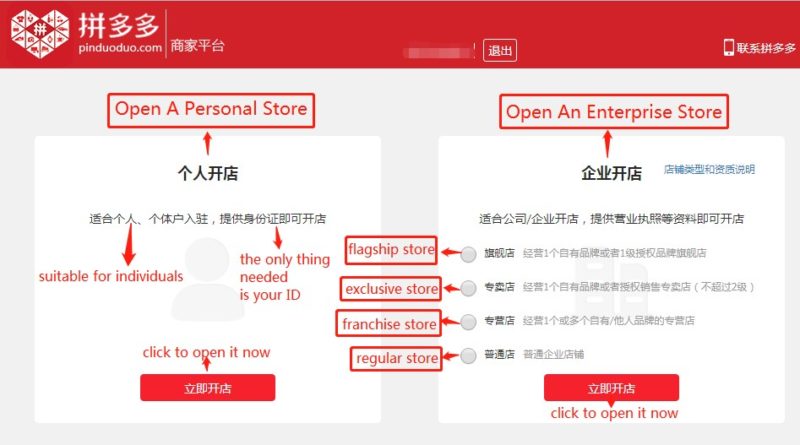
Then it will direct you to the following page where you can input your personal information and then proceed to fill in your store information. A friendly reminder: make sure to have a Chinese cell phone number ready as Pinduoduo currently doesn’t accept overseas contact number.

What are the fees associated with selling on Pinduoduo?
Pinduoduo charges enterprises and small business owners a one-time security deposit fee based on product categories and store types.
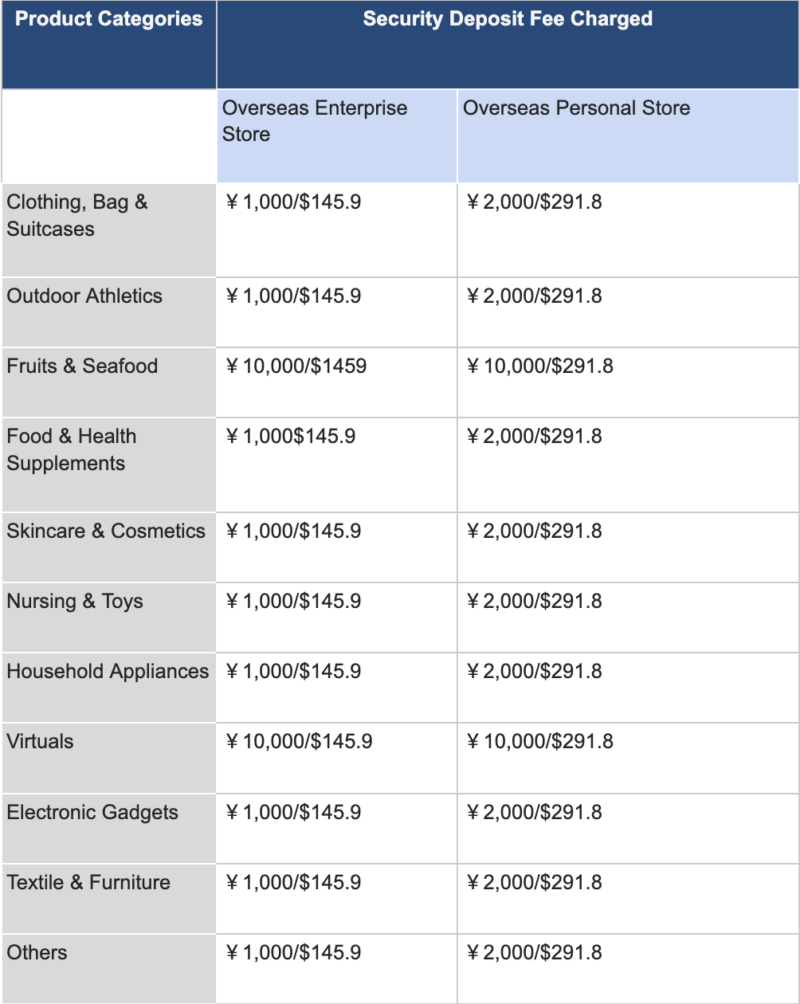
Unlike its western counterparts Amazon and eBay, Pinduoduo does NOT charge commission fees, e.g., final value fee, closing fee, listing fee, or monthly fee. The platform only collects 0.6% transaction fee from sellers on behalf of WeChat pay and Alipay in the occurrence of delivery confirmation and completion of the refund.
Is Pinduoduo the right marketing platform for your online advertising in China?
The answer really depends on a variety of factors, such as your budget plan, the nature of your business, your marketing goals, and most importantly, what your target consumers are. Prior to official entry on Pinduoduo, business owners should be aware that compared to other mainstream e-commerce platforms in China, nearly 70% of Pinduoduo’s users come from tier three and smaller cities.
Knowing this can help you become more prepared in defining your digital marketing strategy in China. For your reference, below are the demographics of consumers of Pinduoduo, Taobao, Tmall and JD.
User distribution


Key takeaways of Chinese digital marketing universe
- Due to the increasing amount of active social media users, digital marketing on social networks has great potential for international brands in China.
- Brands need to choose the right platform and marketing strategy based on their target audience, goals, and budget.
- KOL partnership is especially popular in China in recent years. However, brands need to be careful with choosing proper KOLs that align with their niche and goals.
- Selling and advertising on e-commerce platforms is a convenient way of delivering one’s products to Chinese consumers. Based on the user distribution and niche of each platform, brands may choose their top channels to sell.




